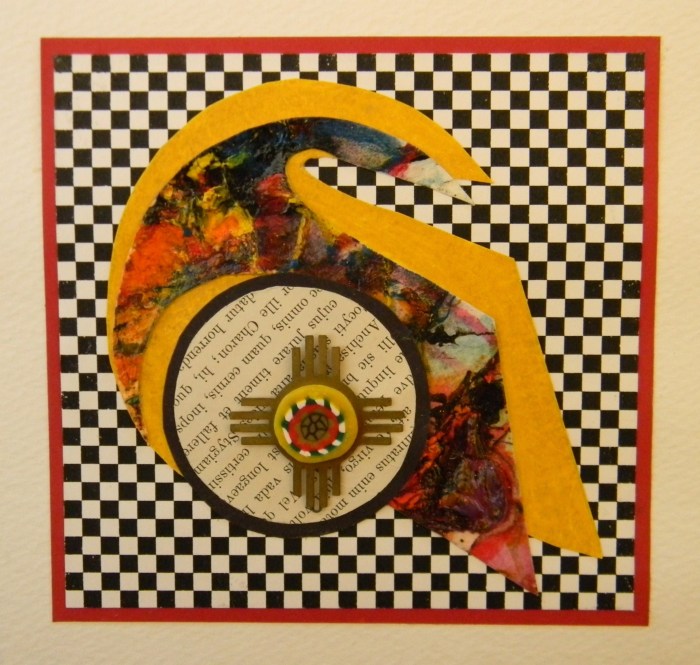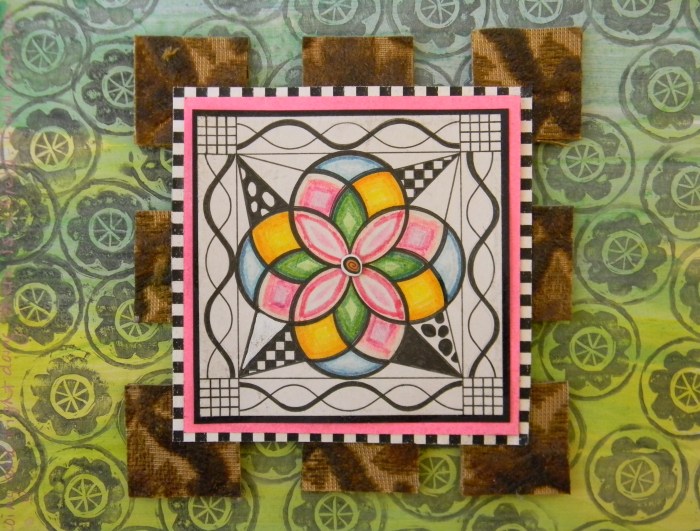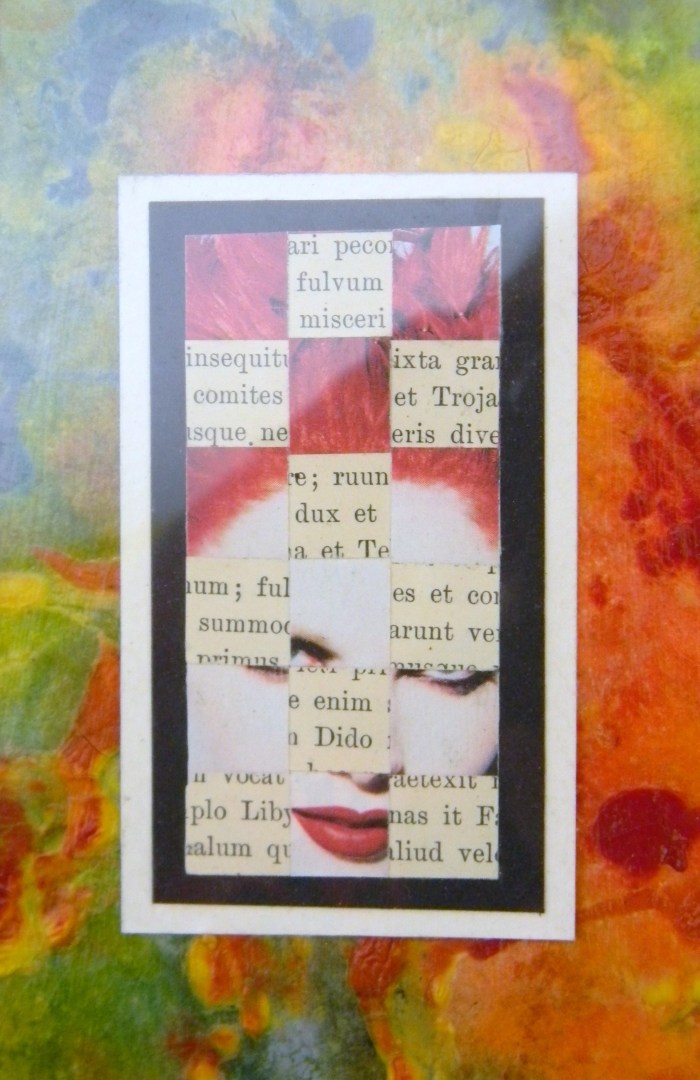As regular readers know, my partner Sara and I are home for several months from our disaster-responding, international-aid-working trek across a crazy planet. Now, as I “memoir” about mental health from Kentucky, a place decidedly less exotic than Hanoi or post-earthquake Port-au-Prince, I’m realizing that creative living on the sane side of the psychotic divide, where I’ve hung out for the past 10 years or so, has only meant less manic making of art, but art-making nonetheless.
Since, my bipolar symptoms have been managed by medication, my art has, in fact, changed, becoming less dark and dour, more optimistic and uplifting–more playful and experimental than desperate and driven.
It seems, having examined my artistic output before and since recovery, I don’t have to be manic to make art; I only have to be child-like and receptive, humble and bent-kneed toward the creative process.
It’s in this spirit of assuming a kneeling posture toward art, that, today, I bring you 3 pieces made, in recent years, by the medicated me.
Hope you enjoy—
This first mixed media assemblage, though not one of my personal favorites, uses a number of techniques I’ve explored in recent years, including collage and bead-making with polymer clay.
This piece in particular is more about experimentation than something overtly conceptual. It’s about playing with text and texture, word and image.
Though it’s difficult to see in the following photo, I edged the perimeter of this next assemblage with a quote by the poet Rumi, “Out beyond ideas of rightdoing and wrongdoing, there is a field. I’ll meet you there.”
In some ways, this piece, like the last, explores a relationship between the Rumi text and a texture that is layered and dimensional. The gold squares in particular were an effort to remember a favorite antique sofa that was damaged beyond repair and had to be discarded. I salvaged what I could, including upholstery that I decoupaged to cardboard and cut into 9 small pieces that add depth and variation to the smooth surfaces in the rest of the piece.
The final mixed media collage uses a technique I explored in the first. When I was still desperately poor but largely recovered from the worst of my illness, I experimented with new ways to use tempera paint, since it was so inexpensive. I couldn’t afford to use the more costly acrylic paint to create texture, so I began applying large amounts of tempera to paper and blowing it with a hair dryer to mix and layer color. Because tempera paint is easy to damage and difficult to preserve, I applied a high gloss polyurethane to increase its durability and create a more reflective surface.
I also experimented in this piece with a collage technique that involved weaving strips of paper. Here text from The Aeneid is woven with a face from a fashion magazine. I thought the resulting checkerboard of Latin text and a red-headed Dido especially interesting.
So, although Sara and I are not gallivanting the globe over the next couple of months, I’m doing a kind of time travel instead–revisiting the disaster of my own bipolar past. Writing a memoir about my ongoing recovery from mental illness means taking inventory of art I created before and since my symptoms have been managed and challenging the myth that a non manic me can’t create as well as the psychotic self I met in psychiatric hospitals across the country.
Rather than writing about the event horizon I encountered in Haiti, I now explore the outback of my own psyche, a landscape that straddles the psychotic divide.






















I just love your artwork! How nice that your exploration of your past has led to such a creative future.
LikeLike
Thanks so much, my friend! I’m delighted you like my work. Stay safe in Japan. Can’t wait to see you this summer, whether in Tokyo or Kentucky!
LikeLike
I especially like the middle piece; it reminds me of a Tiffany window.
LikeLike
Impressive, both your works and your courage in sharing openly, with trust and compassion, your “memoir” about mental health! My sister has only just begun, reluctantly, her journey to discover the nature of the illness that holds her captive. My fondest prayer is that I get her back in my life at some point regardless of who she is then.
LikeLike
Oh, Cheryl, I’m so sorry to hear about your sister. I’m sure my sister said the same thing 15 years ago. I join you in that prayer. Thanks for reading and taking the time to share your story! I hope mine can give you a bit of hope!
LikeLike
Pingback: O is for Only Five Sentences « Woman Wielding Words
Kathy, your work amazes me. I especially love the bottom piece. I hope you don’t mind, but I kind of borrowed your story for my post today. If you don’t approve, I will revise. If you do approve, may I take a couple of your images of your art to add to the post (linking them back to you and giving you full credit, of course)?
Lisa
LikeLike
Oh, Lisa, thank you. I read your post and so appreciate your including me today in the story you share–one that’s mostly about a community of writers that are indeed changing the world for the better–caring, sharing, listening, and loving. I would be honored for you to include some of my images!
LikeLike
Thank you, and I’ve done that.
LikeLike
Cool–I’ll take a look in a bit!
LikeLike
Wow, you’re right–warmer colors, softer lines, more hopeful depictions. Let me ask…when you evaluate your pre-medicated art to your medicated work, do you have a preference for one set over the other?
I love the line by Rumi. That is gorgeous.
LikeLike
The thing that’s weird, Maura, is that I had never taken the time to look at what I’ve done since I’ve achieved a degree of recovery and evaluate it in comparison to what I did before. And, to be honest, I think I like the more recent stuff better! It was harder to access that creative space inside myself, took more time and effort, but, gosh, I really think I like it better! Thanks for asking! And happy birthday, by the way!
LikeLike
The second piece is also my favourite (symmetry again!), although the paper-weaving technique is neat too.
Hugs,
Wendy
LikeLike
Actually, I really love symmetry, as well, Wendy! And the weaving thing was fun to learn–the effect so interesting, I think. Thanks for reading, my friend–hope your week is getting off to a good start!
LikeLike
Beauty, Kathy! These pieces seem alive. Very creative!
LikeLike
Thanks, Marianne! I agree that these have a lively energy–thanks for pointing that out, my friend!
LikeLike
I love recycled art. And, I love Rumi. I also live in Kentucky. You have a great blog.
LikeLike
Thanks so much for stopping by and taking the time to comment! Hope you’ll come back and visit again. Where do you live in Kentucky?
LikeLike
I like the first piece. It reminds me of the design you see of the Red Rooster for kitchens. And I have always loved the look of the black and white squared linoleum. Great work Kathy.
LikeLike
Hi, Marlene–I too love black and white checkerboard–big time–always have. But I don’t know about the Red Rooster. Is it literally a rooster?
Can’t wait to see you in May!
LikeLike
Like the way you explore different media…I every now and then I get the urge to try something like that…but fortunately for those who might have to see it …just scratch it and leave the artwork to people like you who have talent.
LikeLike
Charles–you should try! Absolutely, without a doubt–give it a shot! If you have the urge, just try. I’ve thought from when I first started reading your blog that you were an artist, as your poems have such lovely form–visual form even.
LikeLike
Oh yes, I like these very much. I love that you incorporate text with your images, as well. Especially the Aeneid and red-headed Dido concept…that really tickled me! You know, I think you’re onto something when you say that you can still create, just not manically. Do you find that you enjoy the process any differently now than before?
LikeLike
I don’t know if I enjoy it more or less. I still get the wonderful high when I’m finished, no matter the brain chemsitry at the time. It just takes more effort to create now. Does that make sense?
I’m so glad you enjoyed these as well, Amanda–thanks so much!
LikeLike
Hi, just wanted to stop by and thank you for visiting and commenting on my blog. In fact, I didn’t realize I’d been “freshly pressed” until I read it in your comment!
LikeLike
How funny! I must have been one of your first commenters after FP-ed was posted. Thanks so much for stopping by here, as well! Hope you’ll come back, Dianna!
LikeLike
Beautiful pieces– I also appreciate your nuanced exploration of how you continue to “re-invent the event horizons” when it comes to your blog and the topics you explore here. While you aren’t in Haiti anymore, your own soul and pysche are obviously ripe with wonderful things to examine! It just goes to show that we don’t have to go somewhere far away or exotic to find amazingly interesting things to write about. 🙂
LikeLike
Ah, thanks so much, Dana. You are the first person to notice my revisting the event horizon from different perspectives. I’m go glad you still find the blog engaging, even during our lull in travel.
LikeLike
All of your art speaks, no matter its source. These speak softly, but just as powerfully.
LikeLike
Thanks so much, Renee! And again, congrats on Friday’s FP-ed! You are dear and so damn funny————-
LikeLike
“I only have to be child-like and receptive, humble and bent-kneed toward the creative process.”
I think that sums up the creative process so well. I’ve been running into the idea of being child-like a lot lately, as if the Universe is trying to knock me on the head with a message. lol!
That is one of my favorite Rumi quotes, and the whole combination in that second piece is wonderful. I like them all, but the second jumped out at me a bit more.
LikeLike
The second is my favorite, as well, Robin! And isn’t that a great Rumi quote–I love it, as it always makes me think of Sara! Thanks for taking a peek!
LikeLike
Wow Kathy – these are stunning – I wish I could be more creative in my art – I need to have something to copy from to be any good at all.
LikeLike
But, Jackie, your collage was brilliant. I could NEVER come close to doing that. The ability to reporduce what I see, is a skill I would die for.
LikeLike